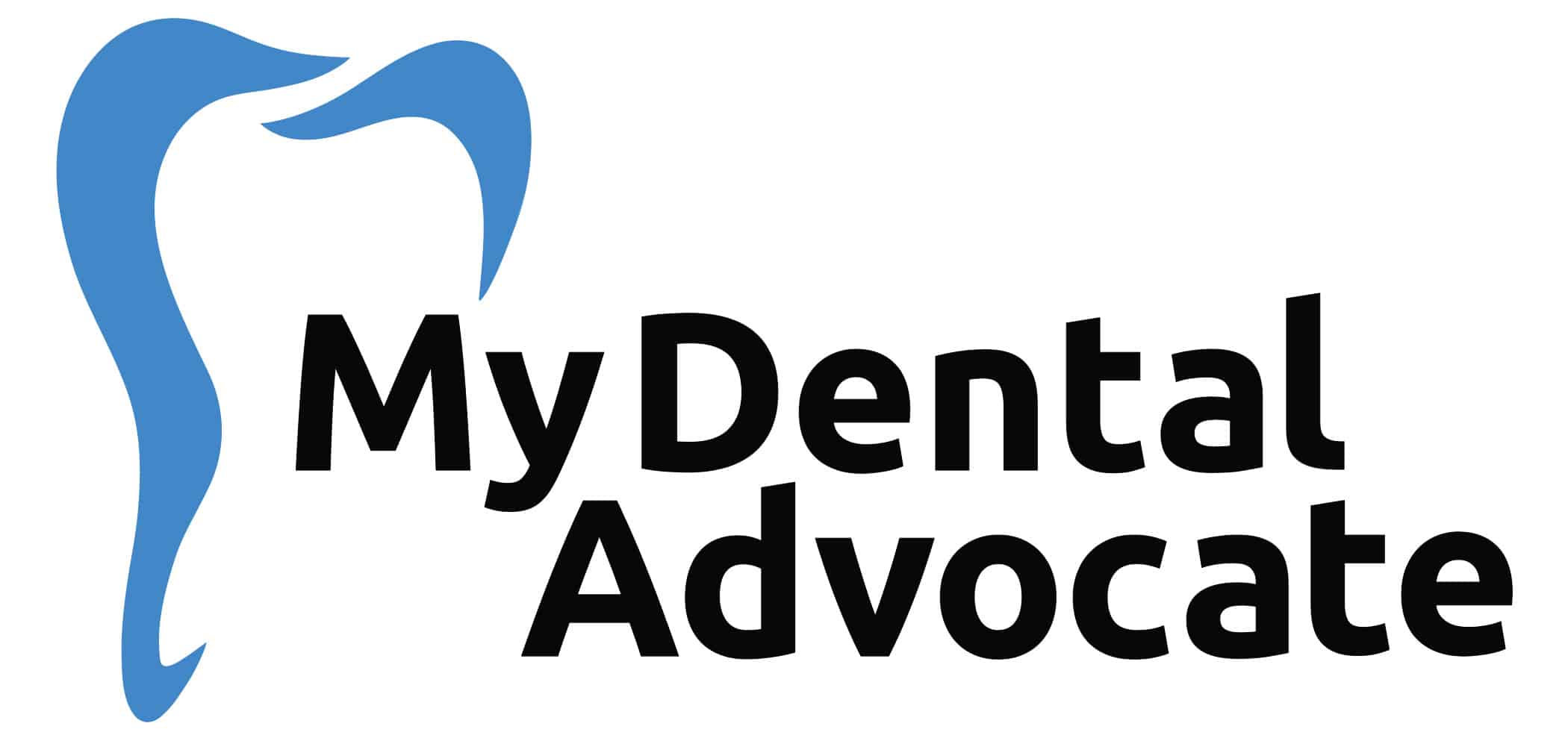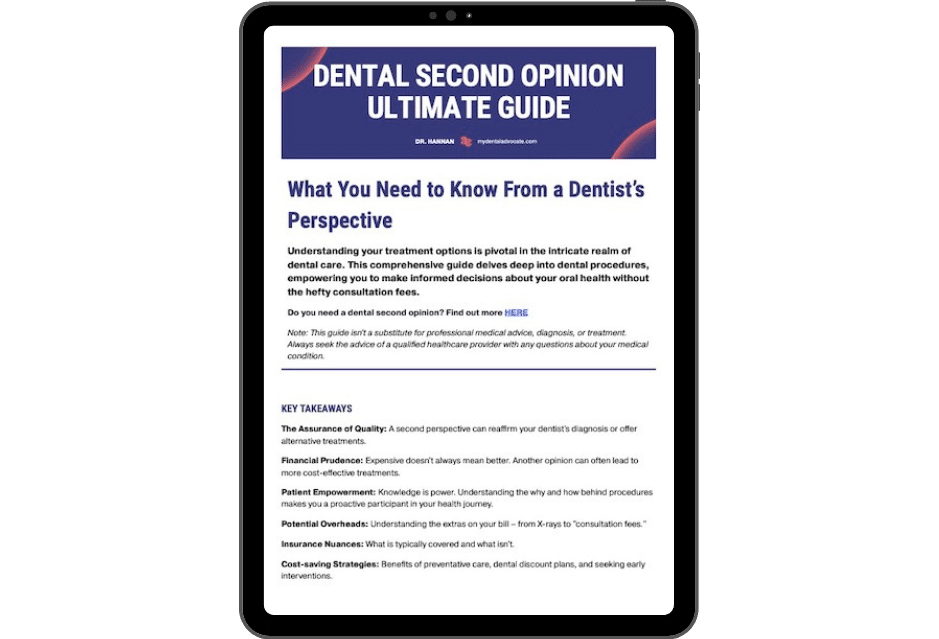When Are CEREC Crowns Not Recommended? (Top 6 Reasons)
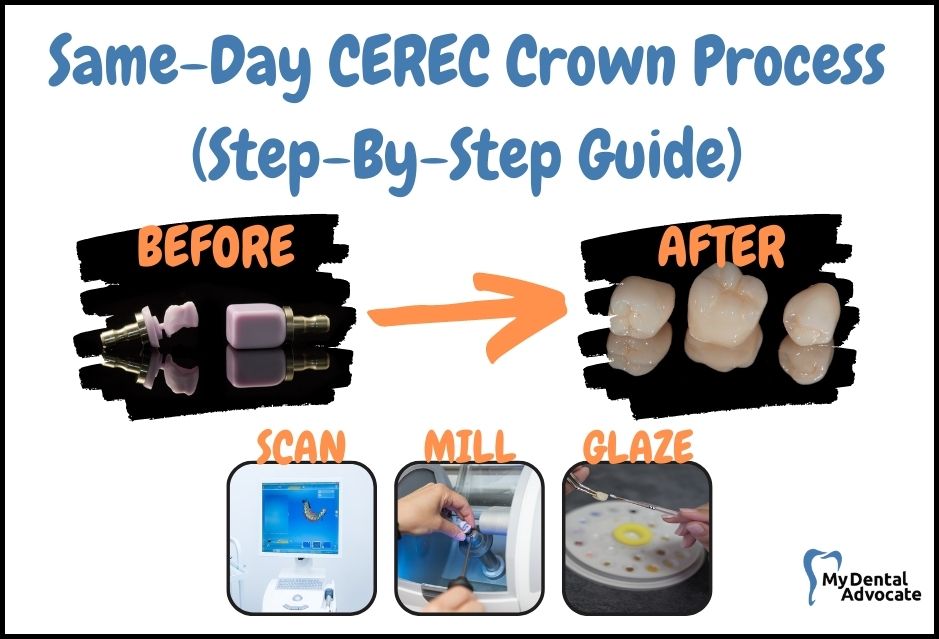
CEREC crowns have become a popular way to restore teeth in recent years.
However, there are some occasions when CEREC crowns are not recommended.
From a dentist’s perspective, we will discuss the top 6 reasons why CEREC crowns may not be the best option for you. Consult your dentist to see if CEREC crowns are suitable for you!
Recommended Reading: CEREC Crowns | The Ultimate GuideNeed Dental Advice? Ask Dr. Hannan!
What Are CEREC Crowns?
CEREC crowns are a type of dental restoration that repairs and protects weak or decayed teeth.
CEREC crowns are fabricated in-office using CAD/CAM technology consisting of an intraoral scanner, chairside computer, and computer-aided milling unit.
CEREC crowns are made from varying ceramics with different strengths, esthetics, and durability.
CEREC crowns are also called same-day crowns because they can be cemented within 2 hours without a gooey impression, temporary crown, or future appointment.
Dentists can use CAD/CAM technology to mill other restorations, including inlays, onlays, bridges, and partial crowns.
CEREC CAD/CAM technology costs $150k+, and not all dentists are equipped with this technology. If your dentist does not have CEREC CAD/CAM technology, dental crowns will be completed at a dental laboratory and take 2-4 weeks.
Recommended Reading: How Much Are CEREC Crowns? (Pros, Cons & Treatment Cost)
Are CEREC Crowns Better than Traditional Crowns?
CEREC crowns are better than traditional crowns in many cases; however, the dentist must consider other factors before recommending a CEREC crown.
For example, CEREC crowns are indicated for patients with limited availability because of work or other scheduling issues. Also, CEREC crowns are durable and highly esthetic, so they match well with other teeth.
Their significant advantage is the same-day crown capability using CAD/CAM technology. The dentist has complete control of the fit and shape of the crown from start to finish.
Suppose the dentist mills out the crown and doesn’t like how it looks or fits; they can mill out a new crown in 6 to 12 minutes.
Types
- Gold crowns
- PFM (porcelain-fused-to-metal) crowns
- Zirconia crowns
- Lab-porcelain crowns
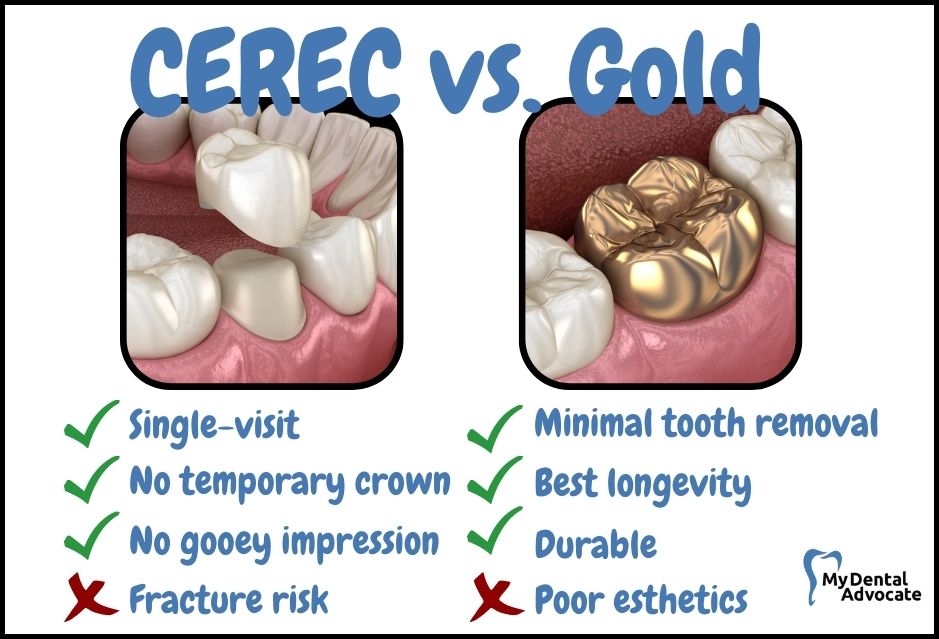
Gold Crowns
Gold crowns are highly durable and have years of extensive clinical research.
Gold crowns are considered the “gold standard” for dental crowns because of their high success rate and longevity.
Unfortunately, gold is unsightly and indicated for molars (primarily lower molars because upper molars can be visible with a broad smile).
Also, gold crowns still require a conventional gooey impression, temporary crown, 2-4 weeks in the dental lab, and subsequent crown delivery appointment.
If the crown doesn’t fit during the appointment the patient has to wait an additional 2-4 weeks.
Gold crowns are best for patients that grind or clench their teeth (bruxism).
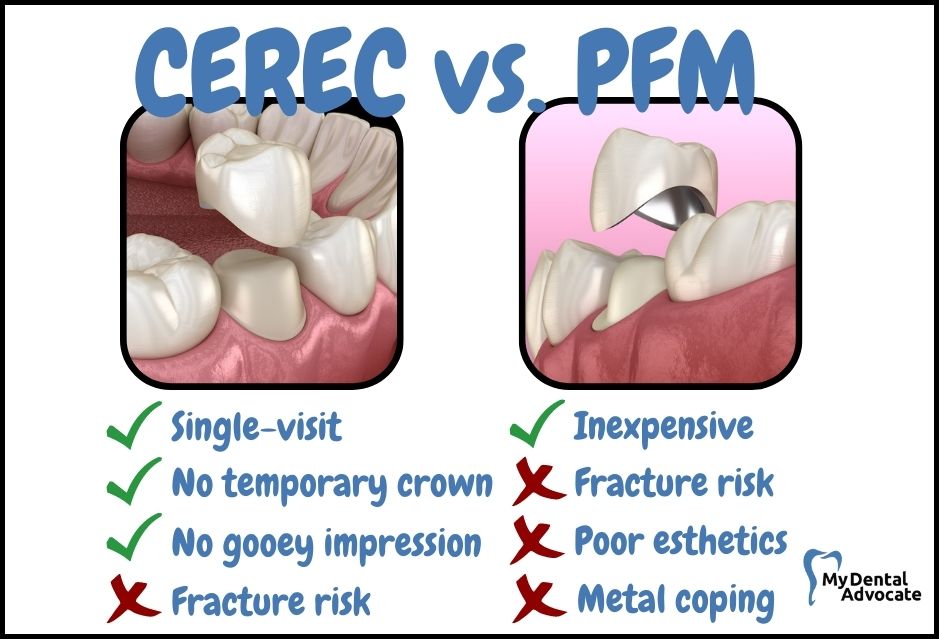
PFM (Porcelain-fused-to-metal) Crowns
PFM crowns are strong, esthetic, and inexpensive. Like gold crowns, PFM crowns have been around for years and have many years of clinical research and development.
Although the metal layer is covered with porcelain, the metal can still show through the crown giving off an opaque shade that can be difficult to match to some teeth.
In addition, the metal collar wraps around the entire tooth, and if it’s not hidden below the gum line or becomes exposed due to gum recession, it can be unsightly and frustrating for patients.
PFM crowns require a traditional gooey impression, a temporary crown, and a subsequent appointment.
Lastly, PFM crowns are prone to porcelain fractures because the bond between porcelain layers or metal can fail.
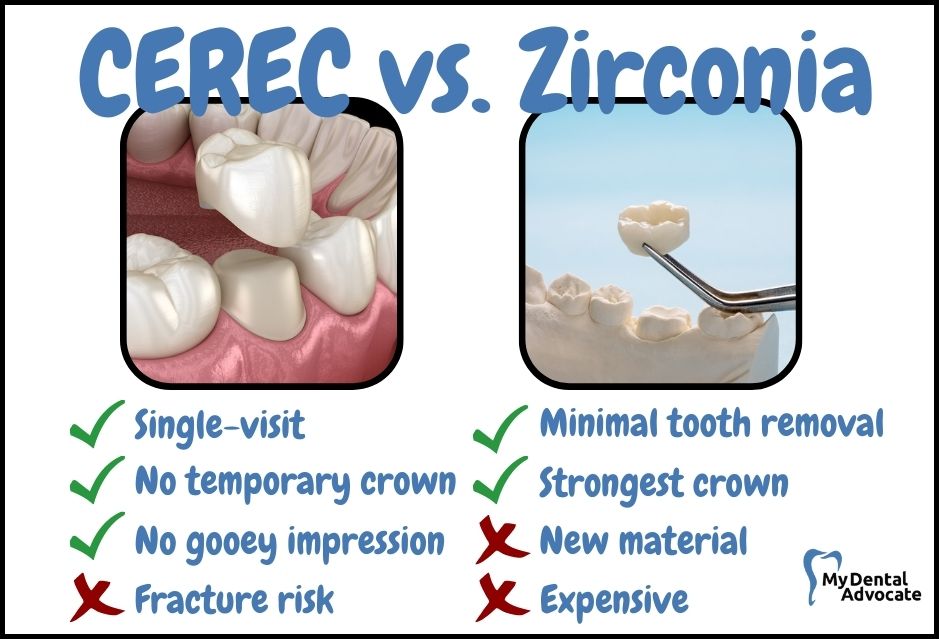
Zirconia Crowns
Zirconia crowns are the strongest dental crowns available.
They have quality esthetics, and although they appear white, zirconia is a type of metal.
Zirconia crowns are more expensive than other traditional crowns; however, they are indicated for patients that grind or clench their teeth (bruxism).
Similar to PFM crowns, the shading appears opaque-like and can be challenging to match to adjacent teeth.
Similar to traditional crowns, they require a conventional gooey impression, a temporary crown, and future appointment.
Zirconia is a newer material with less research behind it; however, CEREC has ceramic blocks reinforced with zirconia for added strength. Also, these CEREC crowns can be fired in an in-office specialized oven for added strength and be delivered on the same day.
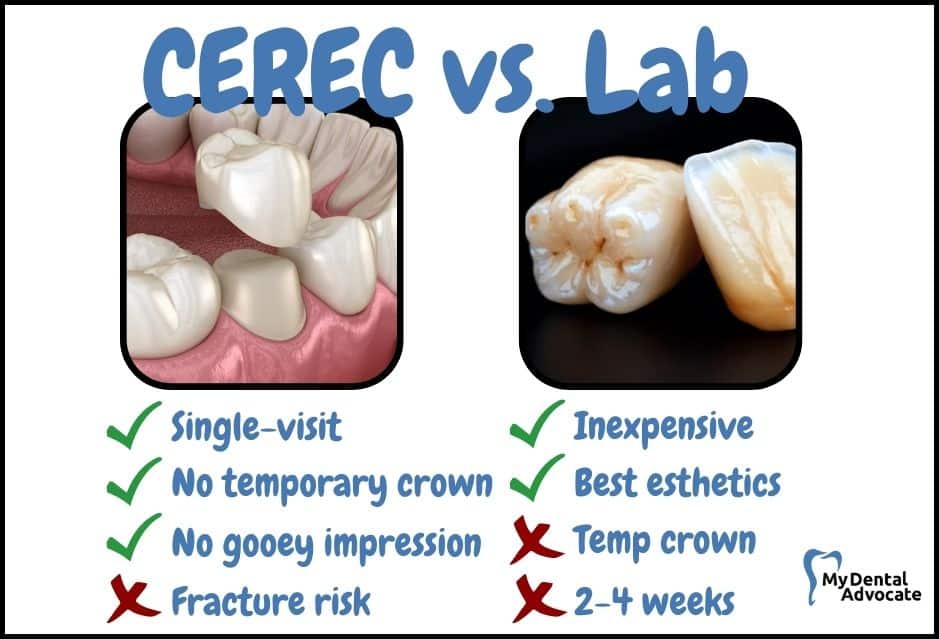
Lab-porcelain Crowns
Dental laboratory porcelain crowns are often more esthetic and less expensive than CEREC crowns.
Lab porcelain crowns are indicated when esthetics are of great concern, and the patient is willing to wait weeks for the crown.
Remember that communication between the dentist and dental lab technician requires exceptional details and instructions, including detailed photos, descriptions, and other essential factors.
In addition, lab porcelain crowns are best for full mouth reconstruction (all crowns) because the lab can spend more time confirming bite position and other important esthetics.
Like other traditional crowns, lab porcelain crowns require a traditional gooey impression, a temporary crown, and future appointment.
Are Dental Crowns Toxic?
According to a recent study, CAD/CAM fabricated ceramic crowns (Si and Al) showed no evidence of cytotoxicity.
In addition, the ranking of elements from most potent to least potent was Zn – Cu – Ag – Pd – Al – Au – Si. Zinc and copper (Zn and Cu) are highly released elements from gold crowns and are the most cytotoxic elements.
Silver (Ag) was the third most potent element and is present in PFM crowns along with other metal alloys. Within the study’s limits, zinc and copper had the most prominent cytotoxic effect on fibroblast cell cultures.
Can Dental Crowns Cause Health Problems?
According to the American Dental Association, dental crowns are safe and effective and suggest toxicity is not a concern for patients receiving this treatment.
However, sometimes patients will mistake dental crown toxicity with an allergic reaction due to materials used in the crown. Patients are encouraged to talk to their dentist about any allergy concerns. In addition, various crown materials are available to prevent any allergic reaction.
The Cleveland Clinic, highly respected research, and medical facility, found no evidence of toxicity associated with dental crowns.
However, they constructed a list of potential side effects associated with dental crowns. With so much information available at your fingertips 24/7, receiving sound medical advice from your doctor and treating dentist is critical.
When Are CEREC Crowns NOT Recommended?
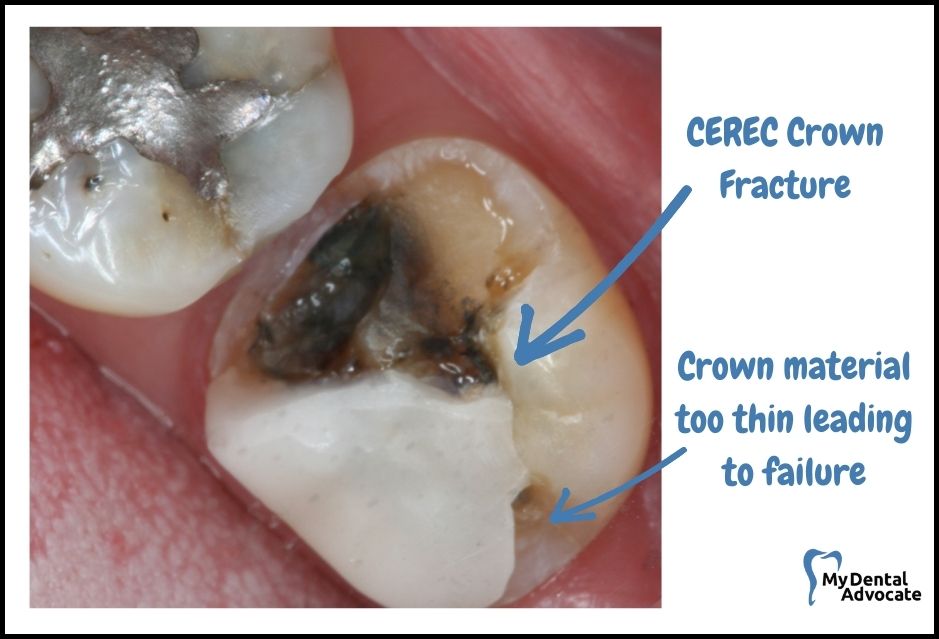
Although CEREC crowns and CAD/CAM technology are highly efficient and provide same-day crown capabilities, it’s not recommended for all case situations.
We’ll discuss in detail the top 6 reasons why CEREC crowns are not recommended and offer an alternative solution.
Not Recommended
- Bruxism (grinding & clenching)
- Inadequate tooth structure
- High salivary flow
- Large cavity (near nerve)
- High esthetic expectations
- Root canal-treated teeth
Recommended Reading: Are CEREC Crowns Better Than Traditional Crowns? (Dentist’s Perspective)
Bruxism (Grinding & Clenching)
Bruxism involves the voluntary or involuntary force of grinding teeth together.
In addition, bruxism is also associated with patients that clench their teeth in a pressure position leading to muscle strain, tooth trauma, and fracture potential.
CEREC crowns are strong and durable for most individuals; however, zirconia crowns are indicated for bruxism patients. CEREC crowns are prone to fracture under heavy stress loads, especially if the tooth is poorly prepared and has multiple sharp edges or if the CEREC crown is milled with minimal ceramic thickness.
Zirconia crowns can be milled to a surprisingly 0.5 mm thickness, whereas CEREC crowns must be at least 2.0-2.5 mm thick.
In addition, zirconia crowns have an overall strength of 900-1200 MPa’s whereas lithium disilicate (CEREC) has an overall strength of 400-500 MPa. CEREC CAD/CAM crowns are closing the durability gap with new zirconia-reinforced ceramic crowns fired in a specialized oven to increase strength.
According to Dentsply, zirconia-reinforced lithium silicate (ZLS) has a strength of 500-600 MPa’s.
Check out this video of a Zirconia crown being hammered into a 2X4!
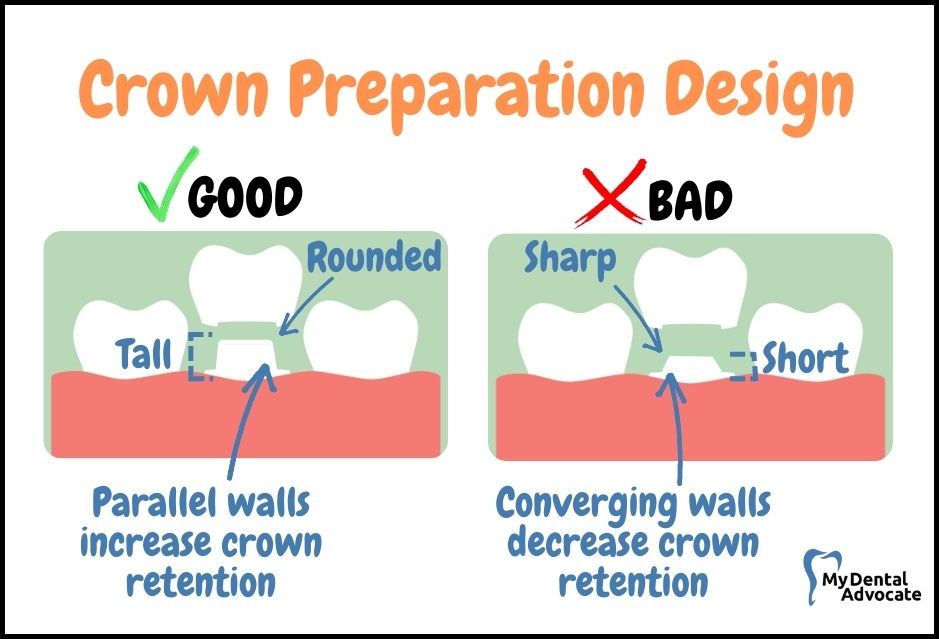
Inadequate Tooth Structure
If there’s inadequate tooth structure, CEREC crowns are not recommended because they require at least 2.0-2.5 mm of ceramic thickness to prevent fracture.
For example, if a lower molar is already shorter than average, trimming down the tooth even more will decrease the crown’s survival rate and lead to the crown potentially falling out.
Zirconia crown would be indicated in this situation because it only requires 0.5 mm thick and extremely strong.
In addition, less trimming of the tooth increases the chances the crown will stay on for an extended period.
Zirconia crowns are great for posterior crowns (molars) because of their strength, durability, and minimal thickness capabilities.
High Salivary Flow
Two types of dental cement are used when securing a crown, traditional cement, and bonding cement.
Traditional cement is less technique sensitive and relies on mechanical properties (height and width of the tooth), whereas bonding cement relies on chemical adhesion between the crown and tooth.
This chemical process requires perfectly dry conditions and is highly technique sensitive. CEREC crowns require this chemical adhesion process.
If the patient has a high salivary flow or excessive saliva, it will be almost impossible to bond the crown in place securely.
Although the dentist isolates the tooth, the time required for bonding allows saliva to begin pooling around the crown, potentially compromising the process. The dentist should consider zirconia or gold crowns in this situation because they can be cemented with traditional cement.
Traditional cement works best in a wet environment, including the tooth’s surface.
If a crown is cemented onto a “bone-dry” tooth, it can lead to tooth sensitivity.
Recommended Reading: How Do CEREC Crowns Stay On? (Top 8 Reasons Crowns Fall Off)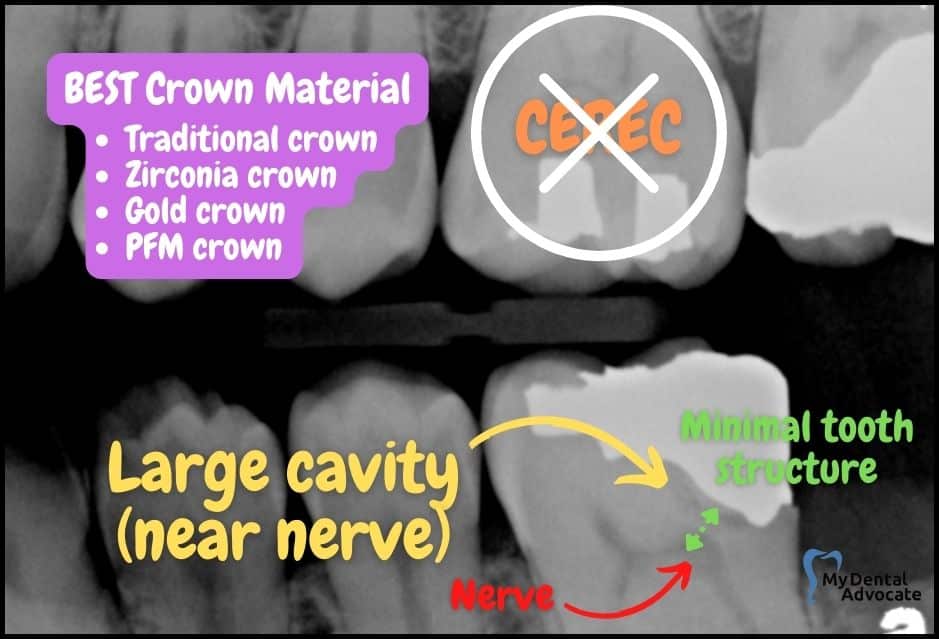
Large Cavity (Near Nerve)
CEREC crowns are secured to the tooth using bonding cement (chemical adhesion).
This chemical adhesion process requires a blue LED curing light to trigger the chemical reaction and solidify the materials. The LED curing light is highly powerful and emits large amounts of heat.
If the tooth had a cavity near the nerve, the cement material would be cured nearby, and the LED curing light could inadvertently heat the nerve to a damaging temperature.
If that occurs, the sensitive nerve tissue (pulp) could be irritated and lead to spontaneous pain, or the nerve could die and lead to root canal treatment.
The dentist should avoid this potential problem by placing a “build-up” near the nerve to protect it from the heat or using a crown that relies on traditional cement (gold, PFM, or zirconia).
High Esthetic Expectations
CEREC crowns are efficient, same-day crowns that provide durability and quality esthetic expectations.
Occasionally, CEREC crowns are challenging to match to adjacent teeth because they have a limited supply of shades and translucency options.
Lab-created porcelain crowns would be indicated in the situation because they can be custom-shaded, and the dentist can send photos of the teeth before and after the tooth preparation.
The dental lab technician is highly qualified to add varying levels of shade and translucency for the best esthetic opportunity. Some dental labs allow the patients to visit the lab for a custom-shade try-in appointment where the dental lab technician can meticulously create the perfect shade.
CEREC crowns are closing the esthetic gap with the ability to custom shade ceramic crowns.
This process is technique sensitive and requires and skilled dentist to match the shades correctly. In addition, the CEREC block requires a subsequent firing step in the specialized oven before crown delivery.
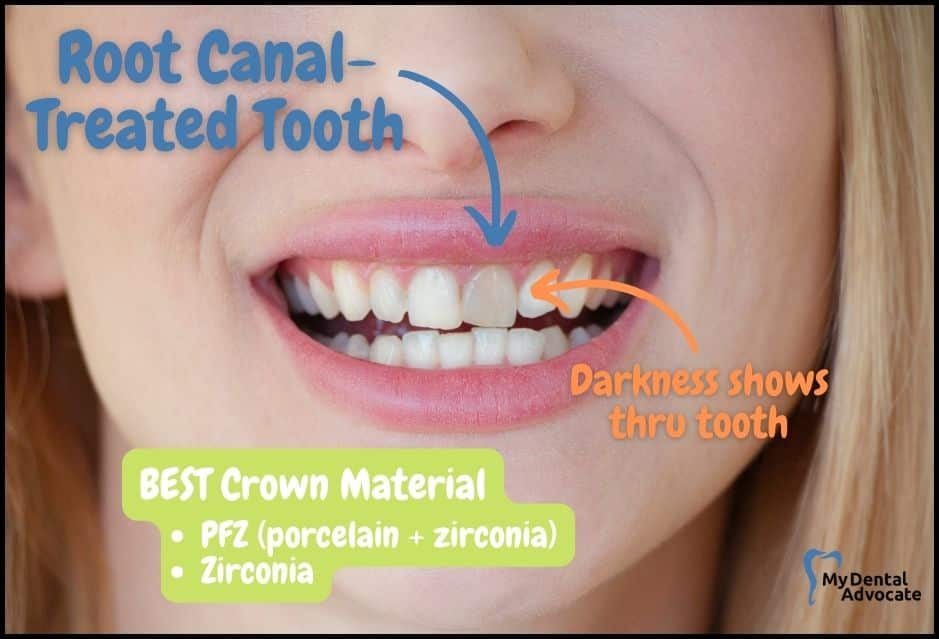
Root Canal Teeth
CEREC crowns work well for most root canal-treated teeth.
However, the dentist may recommend other crown materials, here’s why. After a root canal, teeth are brittle and prone to darken.
CEREC crowns are not always capable of adequately masking the dark color of the tooth.
CEREC ceramic crowns have varying clarity levels, allowing the darkness to shine through.
Zirconia crowns or PFZ (porcelain-fused-to-zirconia) would be an ideal option to mask the dark tooth color while providing exceptional esthetics.
Regarding the brittleness of the tooth, CEREC crowns require 1.5-2.5 mm of tooth removal around all aspects of the tooth to prevent ceramic fractures. If the root canal-treated tooth is weak and brittle, removing more tooth structure will compromise its integrity and decrease long-term success.
Zirconia crowns only require 0.5 mm of tooth structure removal and would also be an ideal option for this situation.
My Experience & Expertise
CEREC CAD/CAM technology has revolutionized same-day crown capabilities.
However, although they are widely desired and match up well against any traditional crown, they have setbacks.
As mentioned, learning more about these top reasons why CEREC crowns are NOT recommended will give you insight into the potential pitfalls of CEREC crowns.
Need a second opinion? We can help! Learn more. Knowledge is power when cultivating healthy dental habits. The more informed you are, the better positioned you’ll be to prevent avoidable and potentially costly dental procedures for you and your family. Watch for future blog posts, where we’ll continue sharing important information, product reviews and practical advice!
Sources
- Elshahawy W. Cytotoxic effect of elements released clinically from gold and CAD-CAM fabricated ceramic crowns. Tanta Dental Journal. Dec, 2014.
- Staff. Are Dental Crowns Safe? The 411 on Dental Crown Toxicity. Dental Health Society. April, 2019.
- Kontonasaki E. Strength and aging resistance of monolithic zirconia: an update to current knowledge. Jpn Dent Sci Rev. Nov, 2020.
- Dental Crowns: What Are They, Types, Procedures & Cares. Cleveland Clinics.
- ADA, American Dental Association
- Dentsply, Dentsply Sirona

About the Author
Dr. Matthew Hannan, also known as “Dr. Advocate,” is a board-certified dentist on a mission to provide accurate dental patient education. He attended Baylor University before completing dental school at UT Health San Antonio School of Dentistry. He now lives in Arizona with his beautiful wife and 4 kids. Dr. Hannan believes everyone should access easy-to-read dental resources with relevant, up-to-date dental research and insight to improve their oral health.

Connect with Dr. Hannan!
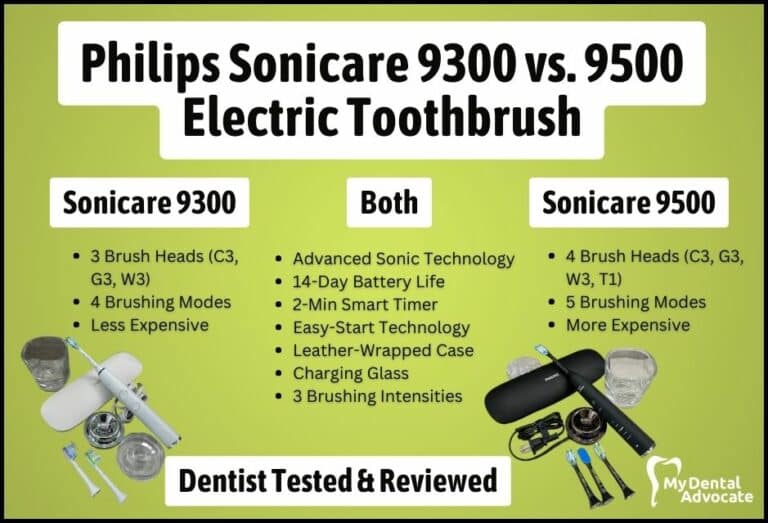
Philips Sonicare 9300 vs. 9500 Electric Toothbrush Review 2024
Navigating the world of advanced oral care technology can sometimes feel like a maze, especially when you’re faced with multiple high-performing models from a reputable brand like Philips Sonicare. As a dentist who believes that a great electric toothbrush is an investment in long-term oral health, I find the 9300 and 9500 models to be particularly impressive. But how do you choose between these two titans of tooth care?
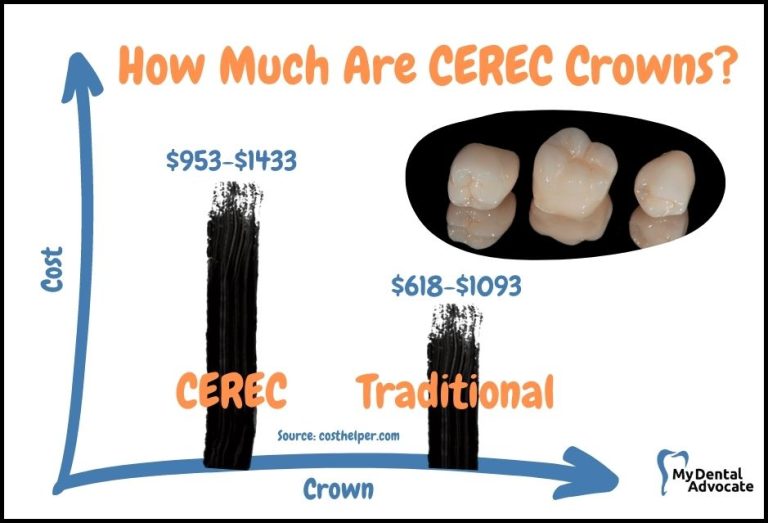
How Much Are CEREC Crowns? (Pros, Cons & Treatment Cost)
Treatment cost for CEREC crowns varies depending on where you live and the dentist’s credentials, but it is typically more expensive than getting traditional crowns. This blog post will discuss the pros and cons…
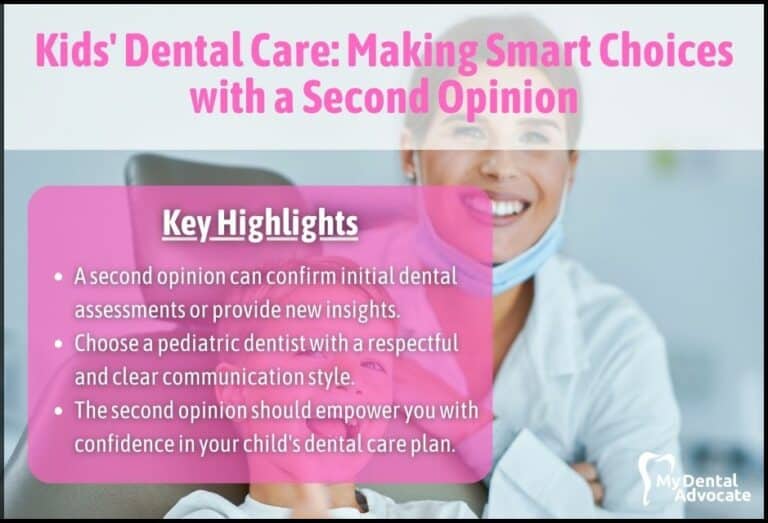
Kids’ Dental Care: Making Smart Choices with a Second Opinion
Kids’ Dental Care: Making Smart Choices with a Second Opinion When you are uncertain or uncomfortable about a diagnosis or…
Gain Clarity with Our FREE Second Opinion Guide
Receive clear, expert second opinions online within 48 hours. Start today!
Product Reviews
Our 250+ dental product reviews (and counting), curated by an experienced dentist, are the most comprehensive online.
Toothbrush Genie
State-of-the-art chatbot designed to help you discover your perfect toothbrush in just a few simple steps!
Cavity Risk Assessment
Cutting-edge digital tool designed to evaluate your individual cavity risk based on your responses to a series of questions.
Gum Disease Assessment
Discover your gum disease risk with our quick and engaging 6-question assessment!
